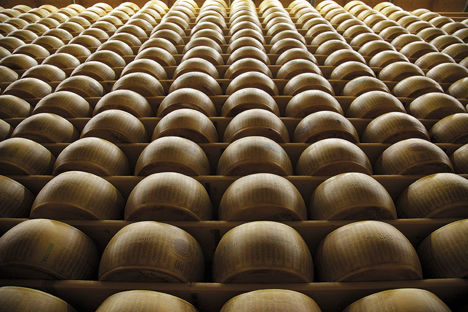
The secrets of Parmigiano Reggiano’s rind
A wheel of Parmigiano Reggiano is a beautiful thing to behold – but all those words, numbers and markings go beyond aesthetics. We find out more about what they can tell us about this legendary cheese.
The secrets of Parmigiano Reggiano’s rind
A wheel of Parmigiano Reggiano is a beautiful thing to behold – but all those words, numbers and markings go beyond aesthetics. We find out more about what they can tell us about this legendary cheese.
One of Italy’s most famous culinary exports, Parmigiano Reggiano PDO is known as ‘the king of cheeses’ for a reason. Not only is it one of the most versatile and popular cheeses in existence; a huge amount of work goes into creating every wheel to ensure they’re of the highest quality required to be approved by the Consorzio del Parmigiano Reggiano. Most of us only come across it in the shops as pre-cut wedges or ready-grated, but all Parmigiano Reggiano begins its life as part of a massive 40kg wheel of cheese.
Over 3.5 million wheels of Parmigiano Reggiano are produced every year in its area of origin: a small part of northern Italy that includes the provinces of Parma, Reggio Emilia, Modena, and parts of Mantua and Bologna. The distinct shape comes from the mould the cheeses sit in for two days, before they’re moved onto the salting and lengthy ageing process. Over time, these wheels firm up and develop their complex flavour until they’re eventually cracked open the traditional way (which involves carefully scoring the rind before sinking a special knife into the cheese to break it open). Over the course of its life, each wheel is adorned with a variety of different marks and stamps, all of which hold specific meanings. Below we’ve broken down the meaning behind each of these etchings to help you better understand what they represent.
Casein plate
Usually found on the flat surface on the bottom of a wheel, a casein plate is applied on one of the two flat surfaces of the cheese wheel during its very first hours of life. This is in effect an identity card for each wheel so that its origin can easily be traced throughout its life. Featuring a unique alphanumeric code, and more recently a QR code, you can find out everything from the dairy where a particular wheel was made to its birthday.
Marks of origin
Also added very early on in the life of a wheel of Parmigiano Reggiano are its marks of origin. These are imprinted by using a stencilling band, which is tightly fastened around the rind. The first of these marks is a number found in three different places on the wheel, which identifies the dairy that produced it; the month and year of production are also found in three different positions on the rind. Meanwhile, the oval-shaped identification mark on every wheel is a legal requirement in the EU for any food of animal origin. However, perhaps the most distinct of all the marks on a wheel are the dotted inscriptions reading ‘Parmigiano Reggiano’ around the entire circumference of the cheese. However, not all of these dotted inscriptions end up surviving the grade selection process.
Grade selection
After twelve months of ageing, every wheel is tested by the Consortium as part of quality inspections. Trained experts are able to detect any defects inside the cheese simply by tapping it with a hammer and listening to the sound. Wheels which pass the test are branded with the official ‘Consorzio Tutela Parmigiano Reggiano’ certification mark and from that moment officially become Parmigiano Reggiano. However, those which don’t match up the exacting standards expected by the Consortium are split into two groups. Those with minor defects in the structure are still branded with the certification mark but are also marked with parallel grooves the whole way around the rind, becoming classified as ‘Mezzano’ or ‘medium-grade’ Parmigiano Reggiano, meaning they’re best eaten young. Wheels which show major defects have a few millimetres of the rind removed to get rid of all the marks of origin. This is known as downgrading and the result is a cheese which cannot be known as Parmigiano Reggiano.
‘Premium’ and ‘Export’
For some of the wheels which have been declared defect-free after twelve months, the journey doesn’t stop there. In fact, most are left to age for even longer, with some dairies requesting for the Consortium of Parmigiano Reggiano to conduct a further quality check after eighteen months. If they’re deemed defect-free at this point, they have a further oval mark affixed to them saying ‘Parmigiano Reggiano Export’. Another certification available to dairies is the ‘Parmigiano Reggiano Premium’ mark, certifying that the cheese is faultless after further quality checks.
Twenty-four-month-old Parmigiano Reggiano is one of the most commonly sold, as it is at this age that Parmigiano Reggiano begins to fully express its typical characteristics. However, as no official age limit has been set, Parmigiano Reggiano can mature for much longer, with thirty-six-, forty-, forty-eight-, and even seventy- or a hundred-month-old cheese available on the market, with each age acquiring unparalleled aromas and flavours.

